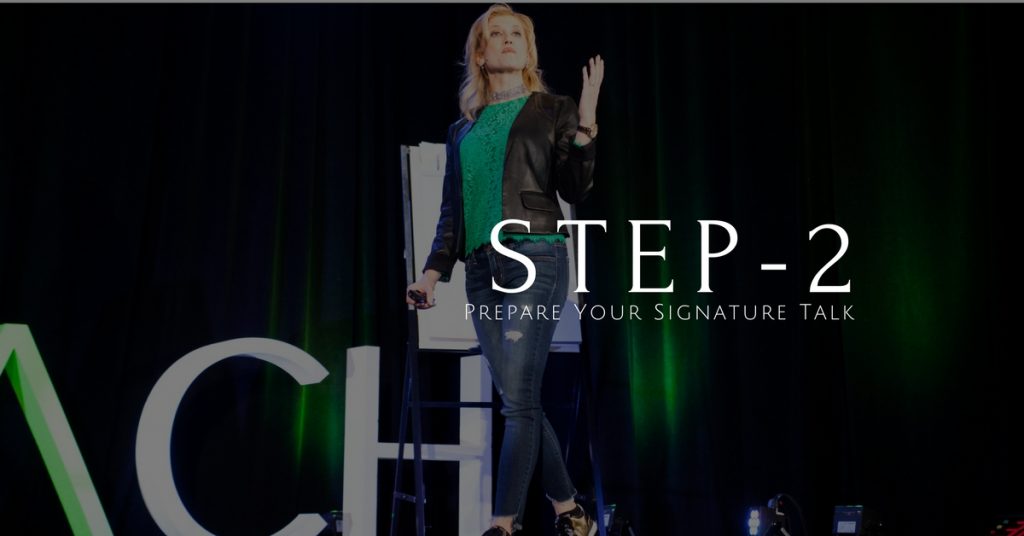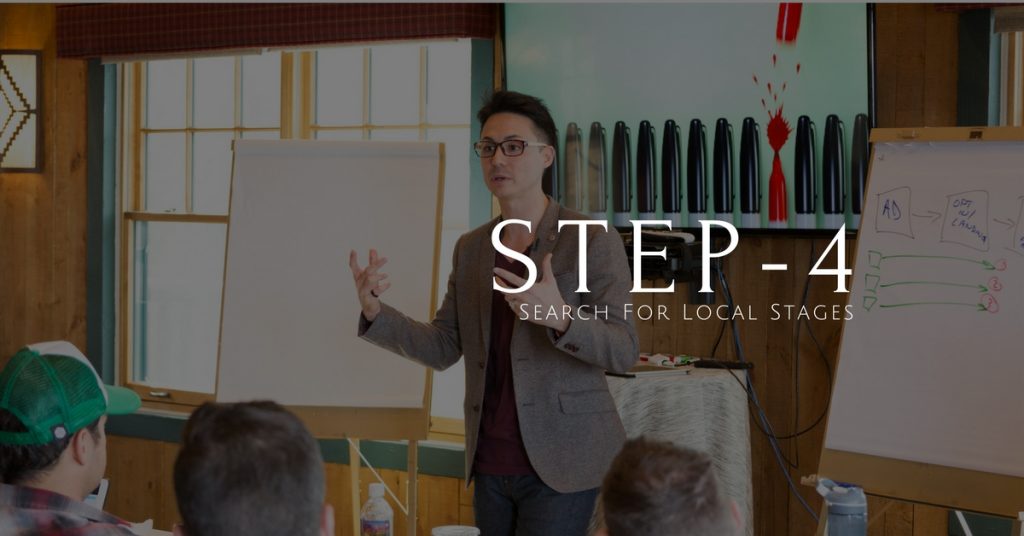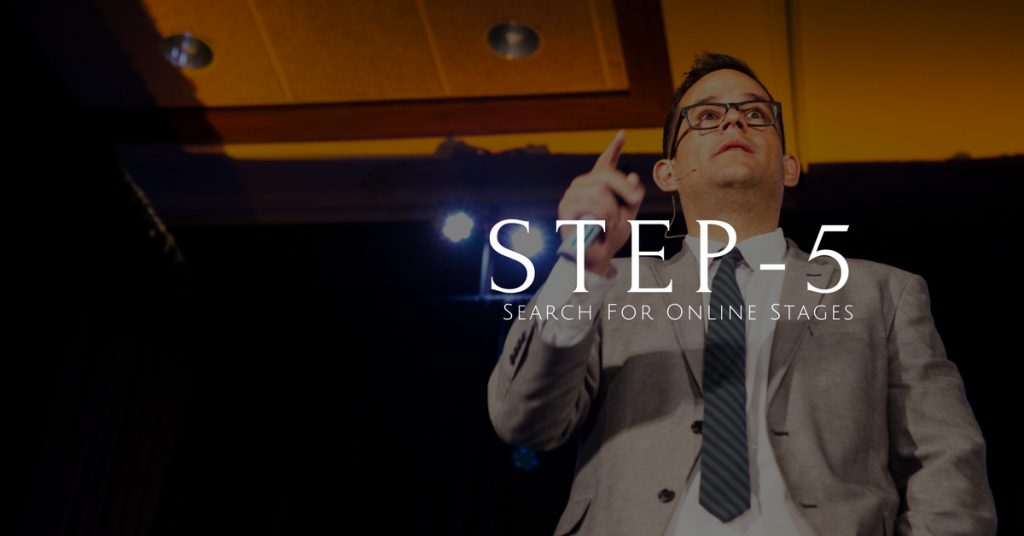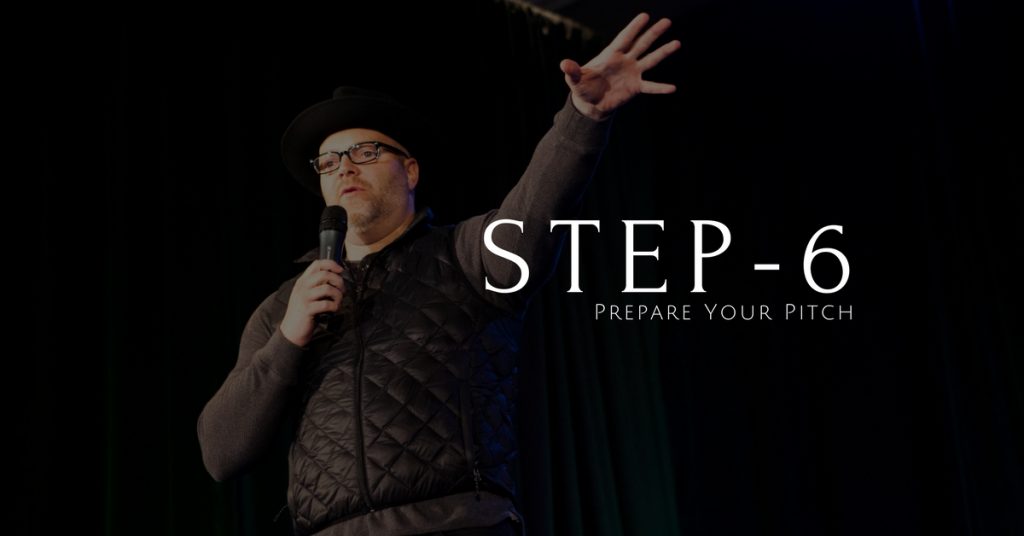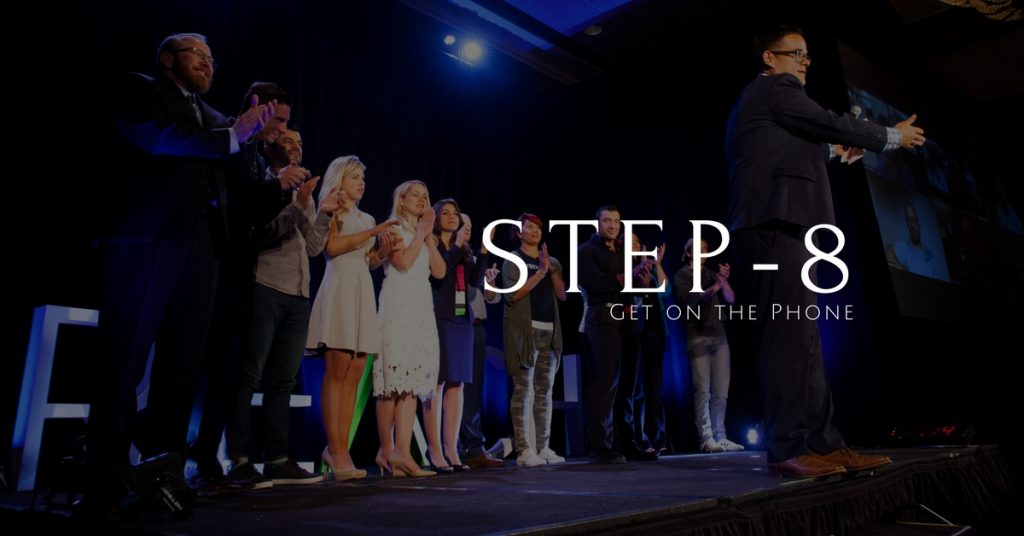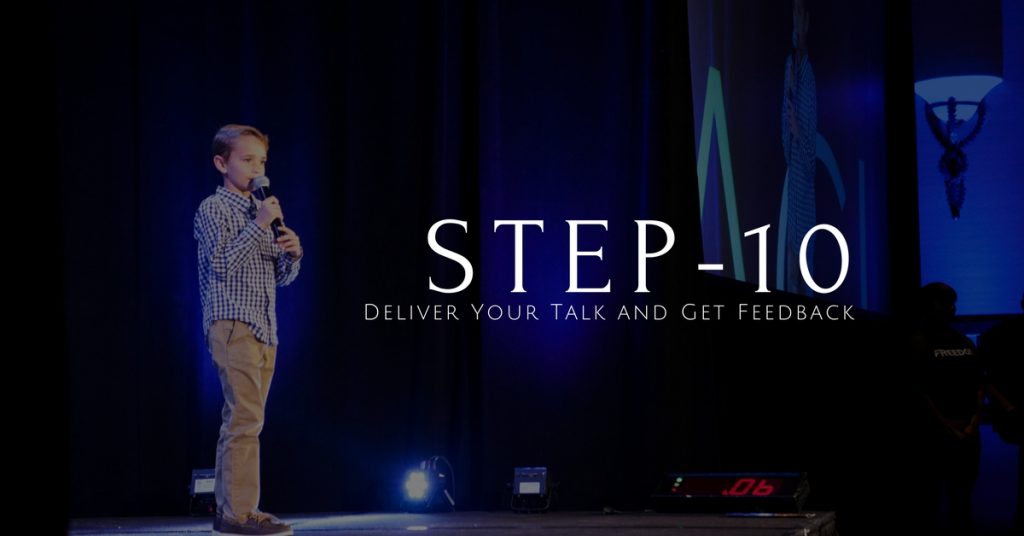Your first 10 stages are crucial for building your speaking career. Whether you want to become a motivational speaker or use speaking to grow your business, landing stages is the way to make it happen. There will be extra challenges landing stages when you first start out because you need to learn how to work with meeting planners, and you need to build up some social proof and promotional materials with these first stages.
We use the Unstoppable Stage Campaign as our main tool for landing stages. But this campaign is highly detailed and can be challenging to set up if you’re just starting out speaking. Plus, some of the biggest and most valuable stages that you want to get onto may take several years to happen, so it’s important to get some quick wins and momentum early in your speaking career.
In this post, we’ll share some quick action steps you can take to land your first speaking gigs, test out your talk and build out some social proof.
Step 1 – Define your target
Before you start anything else, you need to be clear on who you want to reach with your talk — who your ideal audience is that would be interested in your story as well as your product or service.
There are thousands of stages out there, and if you don’t take the time to understand what to look for, then you’ll waste time on stages that don’t benefit you. Worse yet, if you speak on the wrong stages you probably won’t resonate with the audience or the meeting planners, which works against you.
Here are a few questions to help you define what the best stages are for you:
- Who is my ideal customer?
- What makes me different and interesting to them?
- What kind of events would they attend?
- How can I relate what I do the core themes of these events?
- Who are some of the people they follow, and what events are they attending?
Step 2 – Prepare a signature talk
If you want to start landing stages, you’ll need to have a talk ready to deliver. Now that you understand who you want to speak in front of, you need to develop a talk that’s going to touch their hearts and inspire them to work with you. Plus, having your talk prepared will give you some excitement and energy to get it out in front of people.
You should be prepared to speak for 5 to 30 minutes for your first talk. Since these are your first 10 stages, it’s likely that you’ll be getting a lot of breakouts and smaller time slots. These will give you some time to practice and refine your talk as well. If you can master delivering a good talk in 5 minutes, then it’s easy to build out around it.
Step 3 – Ask around
Now that you have a talk ready, you can start searching for speaking opportunities.
The lowest hanging fruit for stages is in your current network.
Take some time to sit down and think up friends, clients, mentors, colleagues and anyone else that both trusts you and may be able to connect you with some events and stages.
Sit down for an hour and brainstorm people that might be able to connect you with some stages, and then reach out (by phone if possible, but email is okay, too).
Here’s a basic script for what to say:
Hi [NAME],
First off, I just wanted to thank you for believing in me and my message. These last few [MONTHS/YEARS] have been so fulfilling for me as I have seen [AUDIENCE] respond to my message of [MY CORE MESSAGE]. You’ve always been so supportive of me, and it means a lot.
Now, I’m ready to take it to the next level. Since I’ve been getting such a great response, I know I can reach even more people with my message. I’m looking for more stages in my area of expertise, which is [NICHE]. These might be podcasts, webinars, online seminars or summits, or actual physical stages.
You’ve been in the industry for a while now, and I wanted to see if you had any recommendations of stages where my message would resonate?
Would you be interested in hopping on the phone (or just replying to this email) with your recommendations?
Thanks again for your support and belief in me; it means more than you know.
Thanks,
[YOUR NAME]
Step 4 – Search for local stages
If you live in or near any large cities, look for local events that you can participate in. Local stages can be more accessible since you don’t need to travel long distances or spend money on hotels to participate. Plus, it’s more likely that you’ll have contact or champion who could connect you with a local stage.
Start to build out a spreadsheet where you can record the names of events, locations, dates and contact information for the meeting planners.
- Conferences in [your city] – A few simple searches in Google can turn up dozens of conferences and events that could be a good fit for you. Try searching “conferences for [your niche/industry/customer] in [your city]”
- Event Centers – Search for event centers in your city, and then look up their calendars. See if you can find any events coming up that could be a good fit for you.
- Associations – Look for associations that serve your target customer. It’s likely they have some local chapters in your city or region that are often looking for fresh speakers and ideas for their audience.
- Meetups – Go to meetup.com and search for meetups related to your audience. Meetup hosts are usually very easy to contact and may be open to having you speak.
- 1 Million Cups – 1Million Cups is an organization for entrepreneurs to present and share their ideas. They have meetups in most cities across the U.S. and are always looking for more speakers.
If you want to land 10 stages, you’re going to need to research at least 30 or 40.
Step 5 – Look for online stages
Remember that stages don’t have to be physical locations. There’s a wealth of opportunity for getting on online stages. You can speak on an online stage from the comfort of your own home while reaching thousands of your ideal customers. There’s also usually a much lower barrier to entry to get onto online stages.
Podcasts – Podcasts are constantly looking for new guests who can speak to their audience. To find good podcasts for you, go to iTunes and search for podcasts related to your niche. iTunes won’t directly link to their website, but once you find the name of the podcast you can search it online and usually find the contact information for the host in a few simple clicks.
Webinars – Many associations, businesses, and online communities host regular webinars for their audiences. Check for opportunities on websites of the associations you researched in the previous step. Also, look for businesses or brands that serve your audience and reach out to see if they would be interested in co-hosting a webinar with you.
Online Summits – Online summits are powerful “digital conferences” that give many people an opportunity to speak. Sometimes summits take an interview format where one host speaks to many different people, while others act more like a collection of webinars.
Try to find another 30 or 40 online stages in this process.
Step 6 – Prepare your pitch
Once you have a big list of stages ready, it’s time to start preparing your pitch for them. This is where many people go wrong. Most just point-blank ask meeting planners for a stage or talk about how much a stage will help their business. This is the opposite of what you want to do.
Your pitch needs to address the wants and needs of the meeting planner and the audience they serve.
Create a signature sentence
A signature sentence is your entire story and signature talk distilled into one crisp sentence. It makes for a perfect opener that explains what you do and catches the attention of the meeting planner from the beginning.
Here’s the basic formula for a signature sentence:
I [action] [who] to experience [what] so they can get [result].
Here are a few examples of signature sentences put together by attendees of Reach Academy Live.
How can you solve the meeting planner’s problems?
Be sensitive to the meeting planner’s situation. They have to sift through hundreds of different speakers interested in what they are doing to put together something that’s a big hit for their audience. Their biggest fears are inviting someone who is a “dud,” difficult to work with or tries to sell a bad product to their audience. Make sure you can address these fears in your pitch.
How can you solve the audience’s problem?
Make sure you can clearly articulate the problems that your audience faces and the value you can add to them.
Collect social proof
Even if you’ve never spoken before, you can get some social proof together to help build trust with the meeting planner.
- Business stats – How many customers have you helped? What kind of results can you get?
- Credentials – What have you studied or achieved that makes you an expert?
- As seen on – Have you been featured on any big websites, media outlets or events that could lend to your credibility?
Set up a speaker page/website
You’ll want to have a speaker page set up so that, when you start your outreach, people will begin to research you. Make sure you have a page to send them to that will present you well.
If you want to learn more about what makes a great speaker page, check out: The Anatomy Of A Great Speaker Page
Step 7 – Introduce yourself
It’s time to reach out to meeting planners and start landing your stages. Most people go straight for the stage with the first contact. That’s like asking someone you just met to marry you. For this introduction, you just want to make a good first impression and open up the doors for more conversation. There are two ways you can do this: with video email or a speaker box.
Video email
Video email is our favorite form of outreach. Using video in your emails is the next best thing to a face-to-face conversation. It gives you the power to convey that extra meaning and emotion in the messages you send and to put a face to your name.
There are a lot of different apps and services out there that can help you add a video to your emails. Our favorite is BombBomb. It’s an incredible tool that makes recording a video from your computer or phone a snap.
Send them a video email introducing yourself, praising the event and asking about opportunities to help out with the event (sponsorship, help with promotion, etc.). Keep the key elements of your pitch in mind with how you can help the meeting planner and the audience in your messaging.
Speaker Box
Instead of doing what 99% of people are doing and trying to reach out via email to meeting planners, you can target the least crowded inbox of your meeting planners: their mailbox.
The speaker box is one of the signature elements of our Unstoppable Stage Campaign. We send it to meeting planners who we want to build relationships with. It includes a few different materials to introduce who we are and what we’re about.
Here are a few things to include in your speaker box:
- A problem solving letter – This letter is all about how you can add value to the meeting planner and solve their problems.
- A promo sheet – This is essentially a printable version of your speaker page. (Pro tip: Make the sheet fit the dimensions of the box you use so you don’t need to fold it.)
- A small gift – Add a small gift that will delight the meeting planner and make a good impression.
- A USB drive – Include video footage of you speaking, and any other information that is better presented digitally.
- A book or other materials – If you have a book or any other materials to share, be sure to include them.
The speaker box can be expensive to send, especially early on in your speaking career, so you may want to be selective in who you send a speaker box to. If you can’t afford to send a box to every person you reach out to, at least send out a problem-solving letter. Don’t ignore the power direct mail can have on getting you noticed.
For more outreach strategies and details on our speaker box, check out: Unstoppable outreach strategies that cut through the noise.
Step 8 – Get on the phone
Once you’re sure your video email or speaker box has arrived, reach out to the meeting planner and try to book a call. Getting the meeting planner on the phone to talk to you will be crucial to landing their stage.
We developed the “Win-win script” as part of The Unstoppable Stage Campaign to make this call a breeze. You don’t just talk about speaking, but opportunities for exhibiting, breakouts or sponsorships that will help the meeting planner be more successful. The core idea of the script is to always be positioning what you do and what you want as a win for the meeting planner.
Immediately after your phone call, make sure to follow up via email and thank the meeting planner for their time. In this email, include the next steps, like your booking process.
Step 9 – Send them a small gift
Also after the call, immediately send them a personalized note in the mail with a small gift or a treat. We recommend Send Out Cards for this. Thank them for their time and reiterate how excited you are to be collaborating with them. Include a small treat like popcorn to make it more memorable for them.
If you want to learn more about the art and power of gift giving, check out Giftology by John Ruhlin.
Step 10 – Deliver your talk and get feedback
With enough outreach, you’ll be landing stages in no time.
With these first 10, you need to be sure you’re collecting good feedback from the audience and the meeting planners so you can not only improve your talk but also collect better social proof to help you land more stages in the future.
Meeting planner testimonials – Ask the meeting planner to do a testimonial for you. You can collect some written testimonials but, if possible, get a good video of the meeting planner enthusing about you and your talk.
Video from your talk – You’re going to want to collect a lot of footage of you speaking for your promotional videos.
Audience ratings – Many events will have surveys where their audience can rate the different speakers and give feedback on their presentations. Most speakers never ask for this information, but it can be a gold mine for social proof and ideas for how to improve your talk.
Bonus Step – Rebound the ones who said “no”
You’re not going to land every stage you reach out to, but you should not lose hope at the first “no” you get. Most people, after getting a “no,” will go quiet and never reach out again, even if it was just a matter of timing that kept them from landing that stage.
Instead, attend the event and introduce yourself in person. This will help the meeting planner to put a face to your name and will show that you support what they are doing. By attending the event you can get a better feel for it and how to position yourself as a good fit for the next one.
Mark the dates of the events even if they say “no,” and follow up once the event is over with a gift and some encouragement. Send them an email or mail them a small treat and acknowledge the hard work they put into the event. This will make a big impression on the meeting planner, and they’ll be more open to letting you speak at the next event.
Conclusion
Stages are everywhere, and they’re easier to win than you think. By following these simple action steps, you should be able to get some quick wins in 30 days or less. This will jumpstart your speaking career and get you on track to landing your dream stages.
If you’re ready to take your stage outreach to the next level check out the Unstoppable Stage Campaign.



